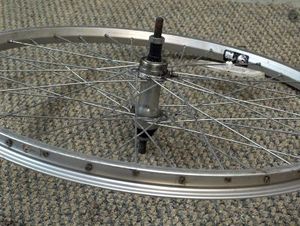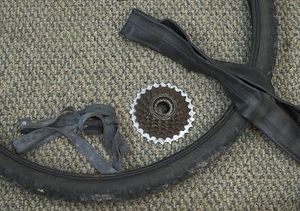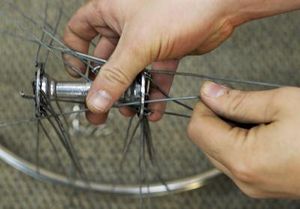Despoking Wheels: Difference between revisions
No edit summary |
|||
| (12 intermediate revisions by 6 users not shown) | |||
| Line 1: | Line 1: | ||
Despoking wheels is a good task for a new volunteer. | '''Despoking wheels''' is a good task for a new volunteer. It also benefits the organization by getting unserviceable wheels converted into several usable parts, and the volunteer benefits by doing a relatively easy and interesting task, getting experience using spoke wrenches and a feel for spoke tension, and learning about the parts of a wheel and about how wheels are constructed. | ||
== Steps == | |||
[[Image:Wheel-ready-to-despoke.jpg|thumb|This is what a ready to despoke wheel looks like.]] | |||
The primary task of despoking is '''loosening the spokes''' so that you can separate the parts of the wheel. | |||
=== Preparation === | |||
# [[Remove the tire]] and tube. | |||
# Remove the [[rim strip]]. | |||
# Remove the [[skewer]], if there is one. | |||
# Remove the gears. For rear wheels, '''GEARS MUST BE REMOVED!''' And done *before* the wheel is disassembled! | |||
[[Image:Parts-removed-from-wheel.jpg|thumb|And these are all things you might take off (but they might already be off).]] | |||
=== Despoking === | |||
[[Image:removing-spokes-from-flange.jpg|thumb|Pull spokes through the holes in the hub. ]] | |||
Continue this until you are left with a pile of spokes, a cup of nipples, a hub, and a rim. If you have to bend a spoke a bit to get it out, that is fine. | # If available, put the wheel in a [[truing stand]]. Otherwise just sit in a chair. | ||
# Find the appropriate [[spoke wrench]]. | |||
# Loosen all the spokes with the wrench, and then you can turn the nipples with your fingers, or from the outside of the rim with a screwdriver. | |||
# Once you start loosening nipples far enough that they come off of the spokes, put the nipples in a cup and you can work each spoke between the other spokes to pull it through its hole in the hub. If it is a rear wheel separate left and and right side spokes into two different piles. | |||
# Continue this until you are left with a pile of spokes, a cup of nipples, a hub, and a rim. If you have to bend a spoke a bit to get it out, that is fine. | |||
'''NOTE:''' If you are using the truing stand, as the spokes get very loose the wheel will become hard to handle and it will be easier at some point to remove the wheel from the stand and continue sitting down. | |||
== Common Problems == | |||
One problem that you might have despoking a wheel is frozen spokes or rounded nipples. If you are turning a nipple and the spoke is turning with it, or if the nipple is frozen to the rim and you are unable to turn it at all, you will not be able to remove that spoke normally. If a nipple is rounded, you can try to remove it using a screwdriver from the back, but sometimes the nipple is rounded because it was frozen. In the event that you cannot loosen a nipple, you will have to cut the spoke using wire cutters, and both the spoke and nipple will be scrap. If you have a rounded nipple that you manage to get loose, keep the spoke and scrap the nipple. | One problem that you might have despoking a wheel is frozen spokes or rounded nipples. If you are turning a nipple and the spoke is turning with it, or if the nipple is frozen to the rim and you are unable to turn it at all, you will not be able to remove that spoke normally. If a nipple is rounded, you can try to remove it using a screwdriver from the back, but sometimes the nipple is rounded because it was frozen. In the event that you cannot loosen a nipple, you will have to cut the spoke using wire cutters, and both the spoke and nipple will be scrap. If you have a rounded nipple that you manage to get loose, keep the spoke and scrap the nipple. | ||
== Sorting == | |||
[[Image:spoke-motel.jpg|thumb|Checking the drawer for 266mm spokes in the spoke motel]] | |||
There are two possible futures for the spokes. If the spokes are in better shape than other spokes of the same length in the spoke motel, they will go there. Otherwise, they will go into the steel scrap bin (the large wire bin under the kitchen table). It is a good idea to measure a [[spoke's length]] early in the process and check the drawer for that length. If you know that you will be scrapping the spokes, you can leave the nipples off and collect them in a pile (you will still save the nipples). | There are two possible futures for the spokes. If the spokes are in better shape than other spokes of the same length in the spoke motel, they will go there. Otherwise, they will go into the steel scrap bin (the large wire bin under the kitchen table). It is a good idea to measure a [[spoke's length]] early in the process and check the drawer for that length. If you know that you will be scrapping the spokes, you can leave the nipples off and collect them in a pile (you will still save the nipples). | ||
The hub and rim will go into the appropriate piles to be sorted. If the rim is steel, the appropriate pile is the art parts bin, where the spokes can be used for creative projects. | |||
== Go Back == | |||
* [[Shop Manual]] | |||
[[Category:How-to]] | |||
Latest revision as of 05:11, 28 May 2011
Despoking wheels is a good task for a new volunteer. It also benefits the organization by getting unserviceable wheels converted into several usable parts, and the volunteer benefits by doing a relatively easy and interesting task, getting experience using spoke wrenches and a feel for spoke tension, and learning about the parts of a wheel and about how wheels are constructed.
Steps
The primary task of despoking is loosening the spokes so that you can separate the parts of the wheel.
Preparation
- Remove the tire and tube.
- Remove the rim strip.
- Remove the skewer, if there is one.
- Remove the gears. For rear wheels, GEARS MUST BE REMOVED! And done *before* the wheel is disassembled!
Despoking
- If available, put the wheel in a truing stand. Otherwise just sit in a chair.
- Find the appropriate spoke wrench.
- Loosen all the spokes with the wrench, and then you can turn the nipples with your fingers, or from the outside of the rim with a screwdriver.
- Once you start loosening nipples far enough that they come off of the spokes, put the nipples in a cup and you can work each spoke between the other spokes to pull it through its hole in the hub. If it is a rear wheel separate left and and right side spokes into two different piles.
- Continue this until you are left with a pile of spokes, a cup of nipples, a hub, and a rim. If you have to bend a spoke a bit to get it out, that is fine.
NOTE: If you are using the truing stand, as the spokes get very loose the wheel will become hard to handle and it will be easier at some point to remove the wheel from the stand and continue sitting down.
Common Problems
One problem that you might have despoking a wheel is frozen spokes or rounded nipples. If you are turning a nipple and the spoke is turning with it, or if the nipple is frozen to the rim and you are unable to turn it at all, you will not be able to remove that spoke normally. If a nipple is rounded, you can try to remove it using a screwdriver from the back, but sometimes the nipple is rounded because it was frozen. In the event that you cannot loosen a nipple, you will have to cut the spoke using wire cutters, and both the spoke and nipple will be scrap. If you have a rounded nipple that you manage to get loose, keep the spoke and scrap the nipple.
Sorting
There are two possible futures for the spokes. If the spokes are in better shape than other spokes of the same length in the spoke motel, they will go there. Otherwise, they will go into the steel scrap bin (the large wire bin under the kitchen table). It is a good idea to measure a spoke's length early in the process and check the drawer for that length. If you know that you will be scrapping the spokes, you can leave the nipples off and collect them in a pile (you will still save the nipples).
The hub and rim will go into the appropriate piles to be sorted. If the rim is steel, the appropriate pile is the art parts bin, where the spokes can be used for creative projects.



